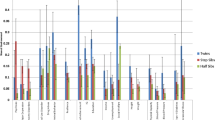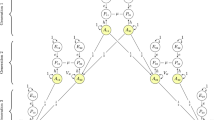Abstract
The “Virginia 30,000” comprise 29,698 subjects from the extended kinships of 5670 twin pairs. Over 80 unique correlations between relatives can be derived from these kinships, comprised of monozygotic (MZ) and dizygotic (DZ) twins and their spouses, parents, siblings, and children. This paper describes the first application of a fairly general model for family resemblance to data from the Virginia 30,000. The model assesses the contributions of additive and dominant genetic effects in the presence of vertical cultural inheritance, phenotypic assortative mating, shared twin and sibling environments, and within-family environment. The genetic and environmental effects can be dependent on sex. Assortment and cultural inheritance may be based either on the phenotype as measured or on a latent trait of which the measured phenotype is an unreliable index. The model was applied to church attendance data from this study. The results show that the contributions of genes, vertical cultural inheritance, and genotype-environment covariance are all important, but their contributions are significantly heterogeneous over sexes. Phenotypic assortative mating has a major impact on family resemblance in church attendance.
Similar content being viewed by others
References
Akaike, H. (1970). Statistical predictor identification.Ann. Inst. Stat. Math. 21:243–247.
Burt, C., and Howard, M. (1965). The multifactorial theory of inheritance and its application to intelligence.Br. J. Stat. Psychol. 9:115–125.
Cattell, R. B. (1960). The multiple abstract variance analysis equations and solutions for nature-nuture research on continuous variation.Psychol. Rev. 67:353–372.
Cavalli-Sforza, L. L., and Feldman, M. W. (1973a). Models for cultural inheritance. 1. Group mean and within group variation.Theor. Popul. Biol. 4:42–55.
Cavalli-Sforza, L. L., and Feldman, M. W. (1973b). Cultural vs biological inheritance: Phenotypic transmission from parents to children (a theory of direct effects of parental phenotype on children's phenotype).Am. J. Hum. Genet. 25:618–637.
Cavalli-Sforza, L. L., and Feldman, M. W. (1981).Cultural Transmission and Evolution: A Quantitative Approach, Princeton University Press, Princeton, NJ.
Cloninger, C. R., Rice, J., and Reich, T. (1979). Multifactorial inheritance with cultural transmission and assortative mating. II. A general model of combined polygenic and cultural inheritance.Am. J. Hum. Genet. 31:176–198.
Darlington, C. D. (1971). Axiom and process in genetics.Nature 234:521–525.
Eaves, L. J. (1976a). A model for sibling effects in man.Heredity 36:215.
Eaves, L. J. (1976b). The effects of cultural transmission on continuous variation.Heredity 37:41–57.
Eaves, L. J. (1977). Inferring the causes of human variation.J. Roy. Stat. Soc. A 104(3):324–355.
Eaves, L. J., Last, K. A., Young, P. A., and Martin, N. G. (1975). Model fitting approaches to the analysis of human behavior.Heredity 41(3):249–320.
Eaves, L. J., Eysenck, H. J., and Martin, N. G. (1989).Genes, Culture and Personality, Academic Press, London.
Eysenck, H. J. (1980).The Causes and Effects of Smoking, Sage, Beverly Hills, CA.
Fisher, R. A. (1918). The correlation between relatives on the supposition of Mendelian inheritance.Trans. Roy. Soc. (Edinburgh) 52:399–433.
Fuller, J. L., and Thompson, W. R. (1978).Foundations of Behavior Genetics, C. V. Mosby, St. Louis.
Heath, A. C. (1983).Human Quantitative Genetics: Some Issues and Applications. D.Phil thesis (unpublished), University of Oxford, Oxford.
Heath, A. C., and Eaves, L. J. (1985). Resolving the effects of phenotype and social background on mate selection.Behav. Genet. 15:15–30.
Heath, A. C., Kendler, K. S., Eaves, L. J., and Markell, D. (1985). The resolution of cultural and biological inheritance: Informativeness of different relationships.Behav. Genet. 15:439–465.
Jinks, J. L., and Fulker, D. W. (1970). Comparison of the biometrical genetical, MAVA, and classical approaches to the analysis of human behavior.Psychol. Bull. 73(5):311–349.
Mather, K. (1949).Biometrical Genetics: The Study of Continuous Variation, Methuen, London.
Mather, K., and Jinks, J. L. (1982).Biometrical Genetics: The Study of Continuous Variation, 3rd ed., Chapman and Hall, London.
McGue, R., Wette, R., and Rao, D. C. (1984). Evaluation of path analysis through computer simulation: Effects of incorrectly assuming independent distribution of familial correlations.Genet. Epidemiol. 1:255–269.
Morton, N. E. (1974). Analysis of family resemblance. I. Introduction.Am. J. Hum. Genet. 26:318–330.
NAG (1991).Fortran Library Manual, Mark 14, Numerical Algorithms Group; Oxford.
New York Public Library (1989).Desk Reference. Simon and Schuster, New York.
Rice, C., Cloninger, C., and Reich, T. (1978). Multifactorial inheritance with cultural transmission and assortative mating. I. Description and basic properties of unitary models.Am. J. Hum. Genet. 30:618–643.
SAS Institute Inc. (1990).SAS Language: Reference, Version 6, 1st ed., SAS Institute, Cary, NC.
Snedecor, G. W., and Cochran, W. G. (1980).Statistical Methods. 7th ed., Iowa State University Press, Ames.
Wright, S. (1921). Correlation and causation.J. Agr. 20:551.
Author information
Authors and Affiliations
Rights and permissions
About this article
Cite this article
Truett, K.R., Eaves, L.J., Walters, E.E. et al. A model system for analysis of family resemblance in extended kinships of twins. Behav Genet 24, 35–49 (1994). https://doi.org/10.1007/BF01067927
Received:
Accepted:
Issue Date:
DOI: https://doi.org/10.1007/BF01067927




